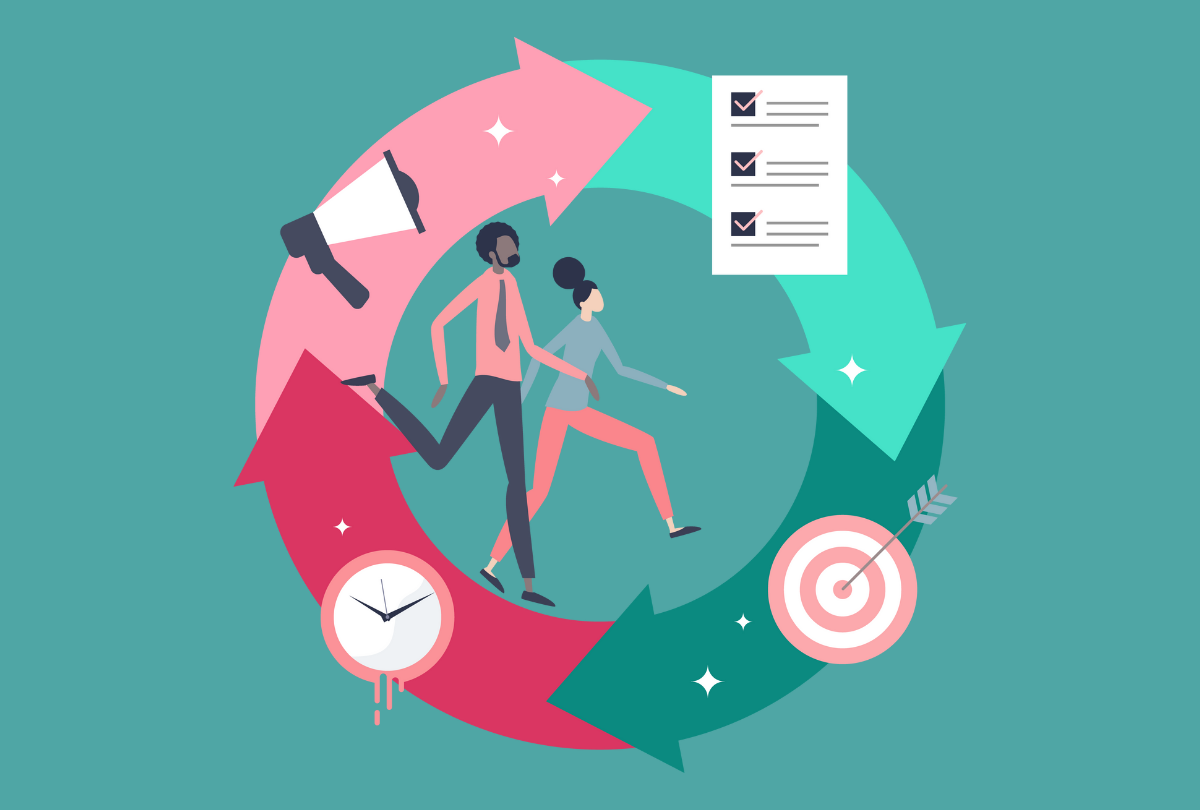Professional development plans are living, breathing documents that lay out the path to achieving professional goals. They may look straightforward, but to be effective, they are the result of a long, well-thought-out process. HR professionals rely on development plans to turn a complex initiative into something that can fit on one page, making an overview much simpler to understand. They can be customized to some extent, but to achieve their intended goals, HR/L&D departments need to follow a detailed method.
<< Download FREE Professional Development Plan Template >>
What Is a Professional Development Plan?
A professional development plan shows the L&D courses an employee will take as they participate in an employee development program. We can define professional development as the initiatives organized by the HR/L&D department to improve employees’ skills.
Organizations have varying methods for planning a professional development initiative. Oftentimes, a major difference is the approach to course evaluation, as many companies don’t concentrate on measuring the effects of L&D on employee behavior (abilities and attitudes). According to the CIPD, only 16% of companies assess the change in employee behavior due to learning and development (instead, they evaluate participant satisfaction). This practice creates problems for a successful initiative (see below).
In any case, here is one commonly used process to guide you when building a professional development plan:
Skills Gap Analysis
A skills gap analysis is an ideal starting point. It involves interviewing both executives and managers to get their opinions on what skills are missing in the organization. Then, it adds the abilities that employees want to acquire as part of their intended career path, if they are qualified. Altogether, the analysis lets you know what skills the organization needs and which employees are able to obtain them. In turn, this tells you what kinds of courses will be part of the professional development plan for that worker.
Performance Targets
Even before a course starts, you should know what it is aiming for. How can you determine that the employee has actually acquired the desired skill and that it is effective in improving their performance? The answer lies in setting goals that measure training effectiveness. Once you have set targets for a particular course/employee, you need to establish a baseline for later reference. That means evaluating the employee’s ability regarding the skill that will be developed before the course starts.
Programming
The next step is to arrange the course itself. If your company decides that internal mentoring is the way to go, then everything can be kept in-house. Otherwise, you will need to contract with external experts, including coaches, technical trainers, and external mentors. But take care to choose experts who specialize in the exact skill that participating employees need (more on this later).
While you are sourcing experts, you should take the opportunity to recruit direct managers to the effort as well. They will be essential for the final part of the professional development plan.
External Resources
Keep in mind that standard classroom-based courses are not the only option for professional development. Depending on the skill that’s required, HR can consider a number of options that might be more effective and efficient at building professional skills. For instance:
- Professional networks where employees can find sources of advice and informal mentors
- Seminars, webinars, and workshops that bring together employees with the same training needs for interactive sessions
- Social media platforms and Massive Open Online Courses (MOOCs)
- Secondary education institutions that provide certification or degree-level programs
- Skills mastery platforms which use expert-led instruction and scalable, multiple learning experiences to build power skills
Training and Evaluation
While the experts provide professional development courses, HR must keep track of the progress of the employees and their level of satisfaction with the learning. Then, when any course concludes, HR reviews the performance targets set at the beginning of the process to look for changes in employee behavior and productivity.
For many companies, the assessment phase depends on employee surveys. But managerial input is just as important. As they are the best witnesses of an employee’s daily output, direct managers are in a great position to tell if a professional development course has been successful or not.
<< Download FREE Professional Development Plan Template >>
How Career Development Can Help
When building a professional development plan, the input of the employee is essential. Some organizations have this information ready to go before a professional development initiative starts, by making career development a standard practice.
In essence, career development asks an employee “where do you want to go?”. Starting with an employee’s ultimate career goal, the career development plan details the courses, metrics, roles, resources, and timeline that will get them there.
Career development is not about a worker freely thinking about their career aspirations. During the process, an HR rep should steer the employee in a direction that they can handle. For instance, if the person doesn’t seem likely to have executive abilities, then HR should guide them towards a rewarding position that doesn’t require such high-level tasks.
Creating a career development plan early in an employee’s career (with occasional updates) enables HR to fit particular workers into the right roles for a skills gap analysis, and then include them in relevant professional development courses.
Professional Development Plan Outlines
There are a lot of steps involved in creating a professional development plan, but actually, the document itself does not need to show all the details. Instead, because a professional development plan is for individual employees, they usually display only the parts of the initiative that are relevant to L&D. This can include:
- Required skills
- Performance targets
- Programming schedule
- Final assessment of performance targets
Professional Development Plans vs. Employee Development Plans
One point of confusion for HR workers is the difference between professional and employee development plans. As stated, professional development is an initiative that is meant to build professional abilities. Put another way, professional development involves the skills that will enable the professional growth of an employee throughout their career, and the resulting plan defines how they will obtain those skills.
In contrast, employee development looks at all of the L&D that an employee might receive. This includes training in functions that are specific to the company like processes, proprietary knowledge, and how the company operates on a daily basis. It can also cover skills that focus on mental and physical health.
Professional Development Goals and Plans
Another area of inconsistent terminology is in the relationship between plans and goals. To distinguish between the two concepts, you should think of goals as the desired end-state of a professional development program.
It’s particularly easy to get confused when defining a goal from the point of view of an employee. For instance, let’s say that a worker’s career development plan indicates an ambition to acquire leadership skills, which is a common objective for employees who eventually want to be promoted. At the same time, the skills gap analysis also indicates a need for better leadership skills.
You could put “build leadership skills” as a goal in your professional development plan, but that’s not accurate. You need to think about why the analysis cited leadership in the first place. Perhaps there is a new strategy in the works and more change management abilities are required. So the goal becomes “increase change management skills”, while the plan lists “leadership course” as the way to get there.
This approach also gives you two more advantages:
- It makes it easier to set performance targets. “Becoming a better leader” is a rather vague objective and difficult to measure. “Increased change management abilities” are more refined and easier to assess, particularly if you have made your goals measurable.
- It allows you to create a personalized development plan. By setting a highly defined goal, you are actually building more of a focus on the specific skill that you want to enhance. Using the above example, if the new strategy requires change management skills, why put employees through a whole leadership course? With an exact goal, you can also construct a more efficient professional development plan.
The Challenge of Professional Development Planning at Scale
The personalized plans mentioned above sound like a nice idea. They allow employees and HR departments to concentrate only on a defined skill, instead of training workers in a general area where they might not require every aspect of it.
The problems start when you need to manage the programming around personalized development. For hundreds of employees, each of whom needs to fill a specific skill gap in the organization, sourcing experts becomes a major issue. For every skill, you must locate a specialist expert who is available and comes highly recommended. On top of that, HR needs to manage the engagement, course, associated materials, and evaluation process for every employee.
The Evolution of Professional Development
Now imagine this procedure as your organization grows and skills need constant updates; it almost seems that an effective professional development plan is a living, breathing document. What your organization needs is a process that evolves with it. Talent development platforms offer an excellent solution for this challenge. Through a single platform interface, HR can locate experts from around the world and in a variety of specialties. All admin functions are handled through the same interface. And, perhaps most importantly, the vital aspect of evaluation can be managed and documented through the platform’s connectivity to employees, supervisors, and HR. All of this is accomplished through scalable technology that is purpose-built for extensive L&D programs.




